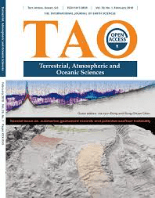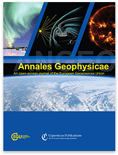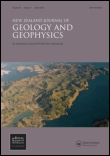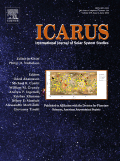
EARTH PLANETS AND SPACE
Scope & Guideline
Illuminating the Path of Geoscientific Discovery
Introduction
Aims and Scopes
- Seismology and Earthquake Engineering:
Research related to the mechanisms of earthquakes, seismic activity patterns, and the development of predictive models for seismic events. This includes studies on stress changes, fault mechanics, and ground motion simulation. - Geodesy and Geomagnetism:
Investigations into the Earth's gravitational field, tectonic motion, and geomagnetic variations. This involves the use of GNSS, satellite data, and magnetotelluric studies to understand geophysical processes. - Volcanology and Geothermal Research:
Studies focusing on volcanic activity, eruption dynamics, and geothermal systems. This includes monitoring volcanic unrest, eruption forecasting, and the analysis of volcanic materials and gases. - Planetary Science and Astrobiology:
Research exploring the geology and atmosphere of celestial bodies, particularly Mars and its moons. This includes studies related to sample return missions, planetary surface processes, and astrobiological potentials. - Ionospheric and Atmospheric Studies:
Research on the interaction between solar activity and the Earth's atmosphere, including the study of ionospheric disturbances and atmospheric waves. This area covers both terrestrial and planetary atmospheres. - Hydrology and Hydrogeology:
Investigations into water movement, groundwater systems, and their interactions with geological processes. This includes studies related to hydrothermal systems and the impact of hydrology on seismicity. - Space Weather and Its Effects:
Research on the effects of solar and geomagnetic activity on the Earth's environment, including impacts on technology and climate.
Trending and Emerging
- Machine Learning in Earth Sciences:
There is a growing trend in applying machine learning techniques to analyze geological and geophysical data. This includes earthquake prediction, seismic data classification, and modeling complex geological processes. - Real-time Monitoring and Prediction Systems:
Research focusing on real-time monitoring of seismic activity, volcanic unrest, and atmospheric phenomena is on the rise. This trend emphasizes the importance of timely data collection and analysis for disaster preparedness. - Interdisciplinary Approaches to Geoscience:
An increasing number of studies are adopting interdisciplinary methodologies, integrating geophysics, geochemistry, and environmental sciences to provide comprehensive insights into complex Earth systems. - Impact of Climate Change on Geological Processes:
Research examining the interactions between climate change and geological processes is emerging as a critical area of focus. This includes studies on glacial retreat, land subsidence, and the effects of extreme weather events. - Planetary Exploration and Sample Return Missions:
Interest in planetary exploration, particularly Mars and its moons, is rapidly increasing. Research related to sample return missions, such as those from the Hayabusa2 mission, is gaining prominence as part of the broader quest for understanding planetary formation and habitability.
Declining or Waning
- Traditional Geological Mapping Techniques:
Research utilizing conventional geological mapping techniques has become less frequent, as advances in remote sensing and geophysical methods offer more detailed and efficient ways to gather geological data. - Basic Seismic Hazard Assessment Models:
There is a noticeable decrease in studies focused solely on basic seismic hazard assessments. This decline correlates with a shift towards more complex, data-driven models that incorporate machine learning and real-time data. - Non-Integrated Studies:
There appears to be a waning interest in studies that do not integrate multiple disciplines or methodologies. The trend favors interdisciplinary approaches that combine geophysics, geochemistry, and data science. - Static Climate Models:
Research relying on static climate models is becoming less common, as there is a growing emphasis on dynamic modeling that accounts for real-time environmental changes and their impacts. - Localized Case Studies without Broader Context:
Studies focusing on localized geological phenomena without situating them within broader regional or global contexts are becoming less prevalent, reflecting a trend towards holistic approaches in earth sciences.
Similar Journals

Earth and Space Science
Leading the Way in Earth and Space Research.Earth and Space Science, published by the American Geophysical Union, is a distinguished open-access journal that has profoundly impacted the realms of earth and planetary sciences as well as environmental science since its inception in 2014. With impressive rankings, including Q1 in both Earth and Planetary Sciences and Environmental Science for 2023, this journal ranks 38th out of 195 in the general Earth and planetary sciences category and 51st out of 219 in environmental science, showcasing its commitment to high-quality research dissemination. The journal serves as a vital platform for researchers, professionals, and students, fostering the exploration of critical topics and advancements within these pivotal fields. With an accessible format, researchers can benefit from the rich content available, furthering their knowledge and ensuring that groundbreaking discoveries reach a broader audience. The journal's ongoing commitment to open access aligns with contemporary trends in scholarly communication, emphasizing inclusion and collaboration in tackling pressing global challenges.

Earth and Planetary Physics
Illuminating the Path of Earth and Planetary ResearchEarth and Planetary Physics, published by SCIENCE PRESS, is a distinguished open-access journal that has been a vital resource for the scientific community since its inception in 2017. With both ISSN and E-ISSN 2096-3955, this journal contributes significantly to the fields of Astronomy and Astrophysics, Atmospheric Science, and Space and Planetary Science, consistently holding a Q2 quartile ranking across these categories as of 2023. Based in the United States, its editorial board consists of renowned experts dedicated to advancing the understanding of planetary phenomena and Earth processes. The journal prides itself on its rigorous peer-review process and broad readership, facilitating the dissemination of cutting-edge research and innovative methodologies. This commitment is reflected in its strong Scopus rankings, positioning it competitively within its scope—rank #33 in Astronomy and Astrophysics and rank #40 in Space and Planetary Science. As an open-access journal, Earth and Planetary Physics is committed to providing free and global access to high-quality research, thereby enhancing visibility and impact for its authors while catering to researchers, professionals, and students eager to explore the intricacies of our planet and beyond.

EARTH AND PLANETARY SCIENCE LETTERS
Driving Innovation in Geochemistry and GeophysicsEARTH AND PLANETARY SCIENCE LETTERS, published by ELSEVIER, stands as a premier academic journal in the fields of Earth and Planetary Sciences, Geochemistry and Petrology, Geophysics, and Space and Planetary Science. Since its inception in 1966 and continuing to 2024, the journal has consistently maintained an impressive reputation, ranking in the top quartile (Q1) across several categories, highlighting its vital role in advancing scholarly research. With a Scopus ranking of #4 in both Geophysics and Geochemistry and Petrology, and a notable 97th percentile in multiple Earth sciences categories, EARTH AND PLANETARY SCIENCE LETTERS provides a platform for groundbreaking research, encouraging rigorous investigation and dissemination of knowledge. While not available as an Open Access publication, the journal remains highly accessible to academics and professionals worldwide, providing invaluable insights and fostering discussions that influence the future of Earth sciences. Whether you are a researcher, educator, or student, this journal is a crucial resource for understanding our planet and its processes.

GEOSCIENCES JOURNAL
Pioneering Insights into Earth's Complex Systems.Welcome to the GEOSCIENCES JOURNAL, a pivotal publication in the fields of Earth and Planetary Sciences and Environmental Science, proudly presented by the Geological Society of Korea. Established in 1997, this journal has become a prominent platform for researchers, professionals, and students, offering a rich collection of peer-reviewed articles that explore a diverse array of geoscientific topics. With an impressive Q2 ranking in both Earth and Planetary Sciences and Environmental Science categories for 2023, it stands as an essential resource in the academic community. Though it operates under a traditional subscription model, GEOSCIENCES JOURNAL remains dedicated to advancing knowledge through rigorous research. Addressed from its headquarters in Seoul, South Korea, the journal aims to foster a deeper understanding of geosciences, encouraging innovation and collaboration in tackling today’s environmental challenges.

Planetary Science Journal
Democratizing Discovery: Open Access to the Secrets of the UniverseThe Planetary Science Journal, published by IOP Publishing Ltd in the United Kingdom, stands at the forefront of research in the fields of planetary science, astronomy, and geophysics. With its open access model established since 2020, this journal aims to democratize access to groundbreaking findings that explore the complex interactions between celestial bodies and their atmospheres, geology, and climates. Recognized for its high quality, the 2023 impact factor places the journal in the prestigious Q1 category across multiple disciplines, including Astronomy and Astrophysics, Earth and Planetary Sciences, and Space and Planetary Science. Ranked favorably among its peers, with notable scores in Scopus rankings, the journal seeks to contribute significantly to advancing our understanding of planetary systems and their formation, encouraging interdisciplinary collaboration among researchers, professionals, and students alike. By fostering a community of innovation and inquiry, the Planetary Science Journal is committed to publishing pioneering research that addresses critical questions of our universe.

TERRESTRIAL ATMOSPHERIC AND OCEANIC SCIENCES
Pioneering Discoveries in Terrestrial SciencesTERRESTRIAL ATMOSPHERIC AND OCEANIC SCIENCES, published by SpringerNature, is a distinguished peer-reviewed journal that has been an essential platform for innovative research in the fields of atmospheric science, oceanography, and Earth and planetary sciences since its inception. With an Open Access policy established in 1990, the journal ensures wide dissemination of knowledge, allowing researchers, professionals, and students to access cutting-edge findings without restrictions. Based in Switzerland and featuring a comprehensive coverage from 1996 to 2024, the journal currently holds a Q3 ranking across various categories, indicating its growing significance in the scientific community. Although it is positioned within the 39th percentile in Earth and Planetary Sciences, its commitment to fostering high-quality research makes it a valuable resource for advancing understanding of terrestrial environments and their interconnections. Researchers seeking a platform for their work in atmospheric and oceanic sciences will find TERRESTRIAL ATMOSPHERIC AND OCEANIC SCIENCES to be an ideal venue for sharing their insights with a global audience.

ANNALES GEOPHYSICAE
Unveiling the Mysteries of Our Planet and UniverseANNALES GEOPHYSICAE is a distinguished open access journal published by COPERNICUS GESELLSCHAFT MBH, renowned for its contributions to the field of geophysics and related disciplines. Since its inception in 1996 as an open access journal, ANNALES GEOPHYSICAE has provided a vital platform for researchers to disseminate their findings covering a wide array of topics within Astronomy and Astrophysics, Atmospheric Science, and Earth and Planetary Sciences. The journal enjoys a commendable reputation, evidenced by its impressive 2023 category quartiles, ranking Q1 in Earth and Planetary Sciences (miscellaneous) and Q2 in several other relevant categories, reflecting its significance in the global research community. Based in Germany and accessible to a diverse audience, ANNALES GEOPHYSICAE serves as an essential resource for academics, practitioners, and students alike, striving to foster advancements in our understanding of geophysical phenomena and encouraging collaboration across disciplines.

NEW ZEALAND JOURNAL OF GEOLOGY AND GEOPHYSICS
Unveiling the Earth's Secrets Through Rigorous Research.NEW ZEALAND JOURNAL OF GEOLOGY AND GEOPHYSICS, published by Taylor & Francis Ltd, stands as a prominent forum dedicated to the interdisciplinary exploration of geological and geophysical phenomena. With an impact factor that situates this journal in the prestigious Q1 category across key subjects—namely Earth and Planetary Sciences, Geology, and Geophysics—it is a critical resource for researchers, professionals, and students alike. The journal has been operational since 1958 and continues to contribute valuable insights into the complexities of the Earth's processes. Although it does not currently offer Open Access options, its broad readership benefits from an extensive archive of high-quality research findings that span from 1958 to 2024. Located in the United Kingdom, the journal remains a pivotal player in advancing the understanding of Earth's systems, making significant contributions to both academic inquiry and practical applications in the field.

ICARUS
Elevating Scientific Dialogue in the Realm of Astronomy.ICARUS is a prominent peer-reviewed journal dedicated to advancing knowledge in the realm of Astronomy and Astrophysics, as well as Space and Planetary Science. Published by Academic Press Inc, Elsevier Science, this esteemed journal has been contributing to the scientific discourse since 1962 and will continue to do so well into 2024. With an impressive impact factor placing it in the Q2 quartile, ICARUS ranks among the top journals in its field, standing appropriately at #22 out of 90 in Astronomy and Astrophysics and #27 out of 104 in Space and Planetary Science according to Scopus metrics. Researchers, professionals, and students alike benefit from its comprehensive scope, which encompasses a wide array of topics related to planetary processes, space exploration, and astrophysical phenomena. Although it does not currently offer open access, the journal remains a critical resource for scholars seeking to disseminate their findings and engage with cutting-edge research in the exciting fields of astronomy and planetary science.

Geofizika
Fostering Collaboration in Geophysical DiscoveriesGeofizika, an esteemed journal published by the Andrija Mohorovičić Geophysical Institute at the University of Zagreb, presents a significant platform for research in the fields of geophysics and Earth sciences. With an Open Access model established since 1984, this journal ensures that scientific knowledge is accessible to a broad audience, encouraging collaborations and the free exchange of ideas. Geofizika has steadily evolved through its converging years from 1989 to 1999 and has been active from 2003 to the present, reflecting its commitment to advancing geophysical research. The journal has been recognized for its contributions to Earth and Planetary Sciences and has acquired respectable ranks in various categories; notably, it holds a Q4 status in Geophysics as of 2023. Researchers, professionals, and students will find Geofizika a valuable resource for the latest discoveries and methodologies in geophysics, supporting the academic community in expanding the frontiers of knowledge in these vital scientific domains.